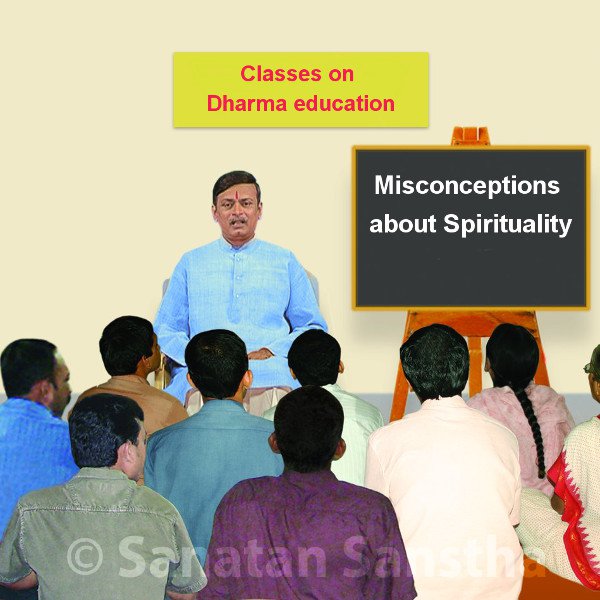Most people, especially the younger generation, have a lot of misconceptions about Spirituality. Therefore, let us understand what these misconceptions are and ‘What Spirituality is not’.
1. Fear
About 30% of the population feels that if God and Saints get angry with them, they will be harmed. As directed in letters which they have received in the name of Saints or God, many people send twenty-five to fifty copies of such letters to others, with the fear that if they do not comply, then they will suffer a great loss. Similarly, people give alms with the fear that if a person in the garb of a mendicant is hurt, then he may wish one ill and may even curse. There is absolutely no reason whatsoever to have such fears. However, due to the fear that if we err, a sin shall be committed and we will be punished by God for it, at least 30% people from society refrain from making mistakes.This is an indirect benefit of this school of thought.
2. Ignorance
There is no connection whatsoever between education which gives worldly pleasures and ignorance about Spirituality. Approximately 90% people from each of the following groups – illiterate, those with primary education, those with secondary education, graduates and post-graduates are ignorant about Spirituality, since they have no formal education in it.
-
An example of such ignorance can be seen in the article, ‘The Ganesh Idol from an aesthetic point of view’ which appeared in a local daily. In this article a famous artist writes, ‘The traditional Ganesh Idol is considered as one of the most beautiful sculptures. I feel like congratulating the anonymous sculptor, the first to materialise this innovative idea into reality’. That ‘Shri Ganesh is an idea’ is ignorance by itself. Deities like Shri Ganesh are not imaginary; they really exist and even have a form. This is what that the poor writer does not know.
-
A saint was once invited to deliver a discourse on Spirituality in Mumbai. The organisers asked Him whether they should provide Him with a chourang (A small square stool used during ritualistic worship) instead of a chair, whether the table should be covered with a saffron cloth and if an oil lamp was required beside Him. They were unaware that Spirituality does not lie in external decoration, but in painting one’s inner self saffron (Attaining vairagya, that is, detachment).
-
Sexuality and ignorance about Spirituality
-
A lady-seeker asked, “On the one hand, you advise me to practise Spirituality and on the other, ask me to lead a normal sexual life and ‘not to refuse’ my spouse. Is this not contrary to tenets of Spirituality?” One should note that, Spirituality does not prohibit sexual life. Saint Tukaram, Saint Ēknath, our Guru His Holiness Bhaktaraj Maharaj etc. had children after they became Saints. The perspective behind this is as given ahead.
-
It is important to overcome sexual desires in Hathayoga; but in Bhaktiyoga (Path of Devotion), it is not important. When the state of spiritual emotion of the person practising Spirituality as per Bhaktiyoga becomes like ‘let the body be in the materialistic world, but the chitta (Subconscious mind) should be at your Holy feet’, he can live Spirituality by performing all the daily chores.
-
When the chanting of a person who is performing sadhana (Spiritual practice) as per Bhaktiyoga (Path of Devotion) continues uninterruptedly, the ‘karma’ he performs becomes ‘akarma’, and as such karma does not ‘bear the fruit of karma’, it does not entrap you in the bondage of karma.
-
As and when our spiritual level increases, our own wish goes on transforming into the wish of others and then the wish of others is transformed into the wish of God. Hence, whatever happens at the level of a Saint normally happens as per God’s wish.
-
The destiny has to be completed only by undergoing it; hence, even Saints normally do not interfere with anyone’s destiny.
-
-
A woman suffering from depression thought that her sexual desire had decreased in accordance with her age. In reality, it can decrease with advancing age, depression and spiritual progress.
-
-
Those following the Path of Spirituality differentiated between Spirituality and the universe. Therefore, they ignored the universe considering it to be Maya (The Great Illusion). Hence, the very zeal for living was over. People became helpless and inactive and led a life devoid of activity under the pretext of attaining Moksha (Final Liberation). This is not true Dharma (Righteousness). (This is an exact description of people performing vyashti sadhana. The life of one following the path of Spirituality should be beneficial for all Creation.)
-
Ignorant notion that, ‘Those believing in destiny are cowards’: It is incorrect to consider one believing in destiny to be a coward. He alone is the true brave one and has the potential to become a Saint.
-
We firmly believe that the reason for the downfall of Hindu society and thereby the entire Nation is Dharma with all its components, festivals, caste system in it, untouchability, temples in every nook and corner with purposeless and shapeless statues.
3. Blind faith
From the example given ahead, we can realise how Bharatiyas are deeply affected by blind faith.
-
Vrundavan (A place in North India) is considered sacred since Shrikrushna resided there. Residents of Vrundavan believe that if someone dies in such a sacred place, the jiva (Embodied soul) gets liberated. Hence, in Vrundavan, a blind faith prevails that the residents of Vrundavan will not be afflicted with any problem due to the souls of unsatisfied ancestors.
The point to be noted here is that, if this were really true, then every corrupt person, a dacoit, a murderer, despite committing numerous sins would finally get liberated. If this happens, it would be injustice to others. God is impartial. The statement that if someone dies in Vrundavan he attains liberation is true only in the case of a devotee or a sinner who is completely repentant, and not others.
-
At one place in Maharashtra, a Pomerian dog is a seat of faith for several devotees of Saibaba, especially the devotees of a specific organisation. It is the faith of devotees that ‘when Saibaba of Shirdi was alive, He gave His vision to His favourite disciples in the form of a dog and then He incarnated on earth in the form of this Pomerian dog’. A procession of this Canine-baba used to be taken out in a silver palanquin every Thursday and on festival days when Saibaba was alive. After ‘Canine-baba’ left for its heavenly abode, the devotees built a samadhi (Mausoleum) and even today, it is ritualistically worshipped with the same faith and a procession of its image is taken out.
The point to be considered here is that if Saibaba had to perform the mission of an Incarnation, why would He take the form of a dog ? Instead, He could come in the form of a human being and easily bring about the welfare of many people. God incarnated in the form of non-humans like tortoise, pig etc., but there was a specific objective behind the Incarnation. Again, all those Incarnations took place in Satyayug. Since the sattvikta of man was higher in Satyayug, he had the ability to understand the language of non-humans; however, in today’s Kaliyug (Era of strife), sattvikta of man is too low and hence, such an event is not possible. God always incarnates as per the need of the time and to supplement His mission. Taking all this into account, it is undoubtedly wrong that a Saint would incarnate in the form of a dog.
-
We consider a cat crossing our path as a bad omen. So should cats never be seen on the road ? If a lizard falls on someone, he feels distressed. These are not superstitions but are premonitions. Should they occur, one should chant God’s Name.
We come across 20% people in the society who have blind faith. Although there is a loss of 10% to the society because of this, there is 20% benefit too, since at least some people refrain from performing bad deeds out of blind faith.
4. Misuse
About 30% people make money under the garb of Spirituality, for instance by starting a ‘yoga’ or ‘pranayam’ (Controlled breathing exercises) class. At one such ‘pranayam’ centre, there was a choice of 18 separate courses of pranayam for improving health, improving concentration, personality development etc. Names of the 18 courses were printed in their pamphlet merely to attract people. In reality, the same pranayam was taught in every course!
5. Cheating
About 95% of the ‘so-called’ ‘Holy men’ are fake.They make money in the garb of mendicants. Some monks give talisman-threads to solve materialistic problems such as getting good marks in examinations, getting a good job etc. By doing so, they are not only cheating the society but they also make the society inactive.
Some Gurus advertise through newspapers that they will initiate with a Gurumantra at a particular time. Disciples of some Gurus also advertise that ‘our Guru gives Gurumantra for Rs.150’. These fake Holy men should realise that, instead of roaming around adorned with gandha (Sandalwood paste) or tilaks, their behaviour should be such that people worship them, only then will they atleast be emancipated spiritually.
Due to these fake Holy men, the image of real Saints gets tarnished. Also, many people lose their precious years in performing meaningless sadhana preached by such fake Holy men.
6. ‘All-knowing’ attitude
About 30% people in the society try to educate the masses on Spirituality pretending to be very well-versed in it, when in reality they know nothing about it. For instance, knowing absolutely nothing about ‘Shriram’, someone wrote, ‘Ram was never ideal. He can never be the seat of one’s faith….. The concept of God itself should be uprooted’. Yet another said, ‘Now let us see to it that God retires!’
7. Of what use is it to us ?
About 55% people feel, ‘let those who have a liking for Spirituality study it; of what use is it to us ?’ They do not know that, in the life of an average person, 20% of physical and psychological problems in wilful actions performed are caused due to factors other than spiritual. The remaining 80% problems are caused by spiritual factors alone. In other words, of every five distressed people, four can acquire happiness merely by undertaking sadhana; so, four out of five people in a family, relatives and friends definitely need Spirituality. Sadhana enhances our ability to endure destiny. All this of course is from the worldly perspective. To attain Moksha, however, there is no substitute for Spirituality.
8. Secrecy
Some people feel that secrecy has to be maintained in Spirituality. Why do people following Āryadharma observe secrecy in Spirituality? In this regard a Saint, Shri Gulabrao Maharaj says – ‘Only those who feel that there is nothing in Vedant other than idle talk say this. When there are trade secrets even in business, why should one feel that there should be none in Spirituality? Besides, one cannot understand the true meaning properly, despite voluminous writings in Holy texts. Secondly, knowledge from Holy texts goes into the hands of people who have no authority over it. Thus, a genre of people is generated, who impart knowledge to others merely by reading Holy texts without completely following the Path of Spirituality. When knowledge is revealed in such a manner, people feel that worldly life alone is more valuable than Spirituality.’
Reference: Sanatan Sanstha’s Holy Text on ‘Introduction to Spirituality‘ and ‘Spirituality‘


 Why do we chant Name of Kuladevi instead of Kuladev?
Why do we chant Name of Kuladevi instead of Kuladev? Remember this while performing the rites of cremation during calamitous times!
Remember this while performing the rites of cremation during calamitous times! Remedies for mental illness arising in an emergency
Remedies for mental illness arising in an emergency how to improve mental strength to face a terrible situation such as a riot
how to improve mental strength to face a terrible situation such as a riot Unique Spiritual experiences of Miss Smital Bhujle after chanting Om Namah Shivay
Unique Spiritual experiences of Miss Smital Bhujle after chanting Om Namah Shivay Do you know, Yogic postures and pranayam accompanied with chanting enhances its benefits!
Do you know, Yogic postures and pranayam accompanied with chanting enhances its benefits!